Introduction
Mammal fossil tracks are relatively rare with fewer than a hundred sites known worldwide (e.g., Eocene of Chuckanut (North America), Oligocene of Sivas (Turkey), Miocene of Navarre (Spain), and Pleistocene of Awash (Ethiopia)). As a fragile memory of the Earth, they form a rich and important geoheritage of outstanding scientific significance, educational value and touristic potential (Page 2018). To date, the Luberon deposits in southern France have produced a dozen track‐bearing localities (Costeur et al. 2009), which makes it one of the richest places in the world for mammal fossil footprints.
In 1979, a tracksite of major importance was discovered in a limestone quarry in Saignon (Vaucluse, SE France, Fig. 1). Thousands of well-preserved footprints were found on the surface of a limestone bed from the early Oligocene (Demathieu et al. 1984). This outstanding tracksite is located in the heart of the Luberon UNESCO Global Geopark (Luberon UGGp). It has been protected since 1987 by the Luberon Geologic National Nature Reserve, which is managed by the Luberon Regional Nature Park.
Fossil footprints are a fragile part of the natural heritage that provide special management challenges. Concern over the condition and long-term preservation of the footprints led to the development of a plan for conservation. We report here on the aims and strategy of the geoconservation project that involve full documentation and 3D digital data capture of the site using photogrammetry, scientific re-investigation, restoration, and the implementation of new in-situ conservation measures compatible with public access, involving the construction of a permanent shelter with low environmental impact.
Location and Geological Setting
The Saignon tracksite is located in a former limestone quarry in the Apt-Manosque-Forcalquier Basin, a few miles east of the city of Apt (Vaucluse, Southern France) (Fig. 1).
The Apt-Manosque-Forcalquier Basin is one of continental basins that originated during the Oligocene in southern France in response to the extensional tectonics (Hippolyte et al. 1993). The filling of the basin is characterized by shallow water continental sedimentation (Nury & Conesa 2000).
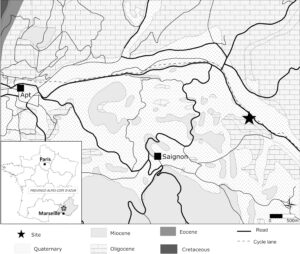
Figure 1. Geographical and geological setting of the Early Oligocene tracksite of Saignon in southern France. (SIT-PNR-PACA, M. Krebs).
The site consists of two main levels (Fig. 2). The lower level (d2, north-west) is about 400 square meters and yielded a thousand mammal fossil footprints on the surface of a micritic limestone bed. Most of the tracks were made by small to large-sized artiodactyls and perissodactyls, some of which are organized into trackways and sometimes show pes-manus impression. The surface yielding the footprints is damaged by numerous natural fractures. The upper level (d6, south-east), stratigraphically 2 m higher, is characterized by the presence of bird tracks and sedimentary structures (ripple marks, desiccation cracks, oncolites).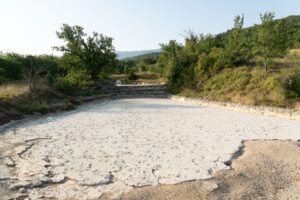
Figure 2. General view of Saignon tracksite. The main level (d2) is dominated by perissodactyl and artiodactyl ichnites. The upper level (d6) has produced almost exclusively bird footprints.
The track-bearing limestone beds belong to the Upper Calcaire de La Fayette Formation which forms the basal unit of the Oligocene stratigraphic series of the Apt-Manosque-Forcalquier basin (Cavelier et al. 1984). Based on studies of gastropod molluscs and charophytes (Feist 1977; Cavelier et al. 1984), ostracods (Apostolescu and Guernet 1992) and mammalian biozones (e.g., Ménouret 2014), this formation is dated to the Rupelian (biozone MP21-22).
The fossil tracks occur within micritic facies composed almost entirely of lime mud with stromatolite-like bacterial mats (Nury & Conesa 2000). The presence of microbial mats has been hypothesized to increase the chance of preservation of tracks by stabilizing the sediment (Marty et al. 2009). The paleoenvironment is interpreted as representative of an ephemeral shallow lacustrine-palustrine system mainly characterized by euryhaline environments. The desiccation features suggest that fluctuations in water levels resulted in regular exposure of large areas (Cavelier et al. 1984).
Geoheritage Significance
The site of Saignon is one of the rare European paleontological sites preserving early Tertiary mammal and bird tracks. A handful of mammal tracksites are also known from Spain (Casanovas-Cladellas & Santafé-Llopis 1974, 1982; Santamaria et al. 1989; Murelaga et al. 2000; Astibia et al. 2007), Turkey (Mesci et al. 2019) and southern France (Ellenberger 1980). The Saignon site is considered as one of the oldest and largest sites, revealing more trackways than previously known at any other site.
Given the rarity of such deposits on a European scale and the diversity of tracks, significant track data are available. The lower level (d2) exhibits thousands of tracks from which can be resolved so far 15 perissodactyl trackways (Plagiolophustipus isp. Fig. 3A; Rhinoceripeda isp. Fig. 3B) and seven artiodactyl trackways (Artiodactipedida Fig. 3C–D). The upper level (d6) preserves bird tracks (Fig. 3E) (Demathieu et al. 1984; Fabre 2020). These fossils, rarely preserved elsewhere, yield valuable scientific data offering unique insights into the terrestrial and lacustrine past ecosystems. The trackways patterns provide unique insight into the behavior, locomotion and paleoecology of the animals that lived in southern France during the early Oligocene. They contribute to increase our knowledge of the biodiversity during the Oligocene, as well as of the general paleoenvironmental context and stratigraphic evolution of Luberon. The Saignon ichnoassemblage includes one of the earliest rhinocerotid record in Europe associated with endemic pre-Grande Coupure forms of ungulate.
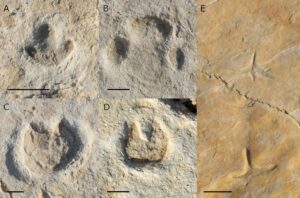
Figure 3. Mammal and bird tracks from Saignon. A–D) perissodactyl and artiodactyl footprints from the main level (d2); (A) Plagiolophustipus isp.; (B) Rhincoceripeda voconcense. C-D) Artiodactypedida indet. E) Bird tracks from d6 level. Scale 5cm.
The Saignon geosite has stimulated high levels of public and media interest, showing the great educational value and the great potential for sustainable touristic use of the site. In June and October 2019, a voluntary community project was conducted to re-excavate the site that was buried under a protective cover since 2001. A constructive ongoing relationship was established with the local people. More than 80 local volunteers and five primary school classes joined the fieldwork (Fig. 4C). The participants discovered basic paleontological techniques and learned about Luberon’s past climate and ancient mammal communities.
The well-preserved exposure and easy accessibility of the site provide excellent opportunities for public visits and educational activities to support the teaching of rocks, fossils and evolution. The Saignon tracksite also offers excellent potential for sustainable tourism and could act as an attraction for visitors to the region. It provides a field where paleontological and geological knowledge can be easily shared, and where people can appreciate the value of these research areas.
Geoconservation Strategy and Procedure
Fossil tracks are unique and surprisingly fragile paleontological heritage sites that are vulnerable to damage and loss to natural erosion processes (Agnew & Demas 2016).
Conserving tracksites poses complex challenges (Feibel et al. 1996; Marty et al. 2004; Santos et al. 2008; Bennett et al. 2013). Usually, options for preservation involve two different strategies: ex-situ (removal of the tracks to a museum) or in-situ (sheltering or reburial) preservation.
In the late 90s, a conservation study of the Saignon site in collaboration with the LERM (Laboratoire d’Etudes et de Recherches sur les Matériaux) showed numerous signs of alteration of the tracks. Natural erosion processes from rain and temperature variations as well as vegetation growth were damaging the site by widening the existing cracks, causing surface scaling, weathering and superficial erosion of the reliefs.
In 2001, the decision was made to bury the tracksite under a protective cover made of multiple layers of geotextile, sand and gravels. This was intended as a long-term preservation measure that could be reversed if resources and technical requirements allowed other options to be pursued in the future.
Almost two decades later, a preliminary assessment of the condition of the tracks was undertaken. Small trenches were opened and revealed weathering of the track-bearing surface (Fig. 4A). Based on these results, re-excavation of the whole site took place in 2019 (Fig. 4B–C). Despite fractures and intrusive root growth (Fig. 4D–E), the surface of the limestone bed bearing the footprints was found to be in good condition generally (Fig. 4F).
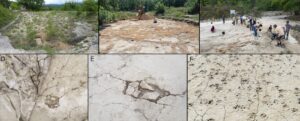
Figure 4. A) Excavation trench prior to removal of the protective cover to assess the condition of preservation of Saignon tracksite. B) Mechanical shovel removing the first layer of the gravels protecting the tracksite. C) 2019 re-excavation of the site the help with local volunteers and primary schools. D) Growth and penetration of roots in the geotextile and weathered limestone surface. E) Natural fractures on the track-bearing surface. F) Main level (d2) footprints excavated in 2019.
Following excavation, the site was documented photogrammetrically. 3D maps from drone images and high-resolution 3D models of the tracks were created. The photogrammetric data were used to generate high-resolution contour line (Fig. 5B) and false-color depth maps (Fig. 5C) of the site and individual trackways. To complete the work by Demathieu et al. (1984), a scientific re-study project was conducted in 2020 including detailed formal descriptions of the morphotypes present in the tracksite (Fabre 2020).
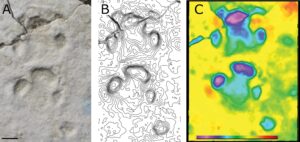
Figure 5. Detailed images of the manus and pes prints of a large perissodactyl (Rhinoceripeda isp.). A) Photograph of the right manus and right pes prints. B) Contour-line of the right manus and right pes prints. C) Depth color map of the right manus and right pes prints. Scale 5cm. After M. Belvedere.
Conservation treatments were conducted on the site. They aimed primarily at eliminating the vegetation and intrusive root growth and filling the cracks with a natural lime-based grouting. Lime and acrylic resins were applied to stabilize broken fragments on damaged prints.
Currently, strategies for in-situ preservation by building a protective shelter are being assessed. The site management plan for permanent sheltering includes visitor walkway and educational interpretation trails. In Europe, sites such as Ipolytarnoc in the Novohrad-Nógrád Geopark in Hungary (Szarvas 2007) represent similar development around fossil mammal footprints. A sustainable approach is being developed, comprising a green, energy-efficient building using a solar power system with a reduced environmental impact. The main benefits of building a protective cover include the conservation of the site, the creation of a place where visitors can see and learn about fossil tracks as well as the production of solar energy. The two main challenges are to ensure adequate protection and to provide sustainable maintenance over time. To handle these challenges, the geoconservation strategy requires the long-term involvement of all the stakeholders, and the development of regular educational activities, field training and academic research projects, guided visits and conferences for the public.
Acknowledgments
The authors express sincere thanks to all the volunteers who worked on the excavation of the Saignon tracksite. We also thank Dr. Matteo Belvedere from the University of Florence and Emmanuel Fabre who worked on the scientific study of the tracks. Special thanks are extended to Christine Balme, the former curator of the National Geologic reserve of Luberon, for all the work she has done to protect and promote the conservation of this site since the 1980s.
Conflict of Interest
The authors declare that they have no competing interest
